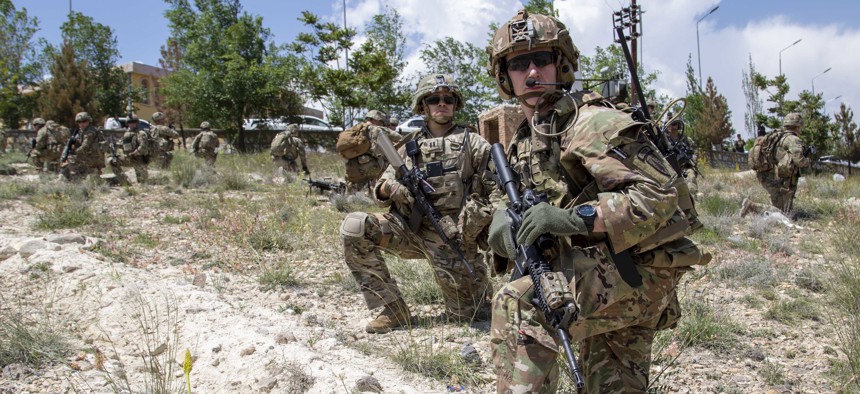
Advisors from the 2nd Security Force Assistance Brigade conduct an advisory mission in Afghanistan in May 2019. U.S. Army
Fighter Jets Leave Afghanistan as US Departs Bagram
Withdrawal from the mammoth base comes as officials continue to seek access elsewhere in the region.
U.S. troops vacated their last operating base in Afghanistan on Friday, effectively marking the end of a 20-year military campaign launched to avenge the Sept. 11 attacks but that had faded from the public eye and devolved into what the White House called “not a winnable war.”
Departing U.S. forces turned over Bagram Airfield, a massive base that had been at the center of military operations there since 2001. But questions remain about how the United States will support its post-war military and diplomatic presence in the country.
U.S. force presence now will be centered around Kabul. The few remaining U.S. military aircraft will be located there, as will other U.S. forces, to secure the primary transit point for U.S. personnel and potentially thousands of Afghan translators who worked with the U.S. military over the last two decades and who are seeking to flee the country.
“Security at the airport is still a concern,” Pentagon press secretary John Kirby said at a briefing Friday.
“There are some aviation elements that we retained at [Kabul] airport, but in terms of the kinds of the strike capabilities I think you are talking about, those are no longer in Afghanistan,” Kirby said, responding to a question on whether the aircraft that had been based at Bagram were still in the country.
On Friday, Defense Secretary Lloyd Austin approved the transfer of command of forces in Afghanistan from Gen. Scott Miller to the commander of U.S. Central Command, Gen. Frank McKenzie, effective later this month, Kirby said.
Miller is expected to remain in the region for the next several weeks but authority to call in airstrikes for over-the-horizon support would transfer to McKenzie. Authority over the personnel remaining in-country, renamed U.S. Forces Afghanistan-Forward, is transferring to Navy Rear Adm. Peter Vasely.
The closure of Bagram, one of the places where U.S. special forces invaded in October 2001 to begin targeting Taliban and al Qaeda positions, took place just two days after the death of former Defense Secretary Donald Rumsfeld, one of Operation Enduring Freedom’s central architects.
Rumsfeld’s support for launching Operation Iraqi Freedom in 2003, just as military operations in Afghanistan were making progress in stabilizing the country, has been widely cited as one of the main reasons that military resources and funding for Afghanistan operations dwindled, and those gains began to slip back into Taliban control.
The White House expects to complete the withdrawal from Afghanistan by the end of August, ahead of the original Sept. 11 deadline set by the president, spokesperson Jen Psaki said at a briefing Friday. Psaki also said Afghan translators who have applied to come to the United States because of Taliban violence will be evacuated from Afghanistan before that, but declined to give any details, citing security reasons.
President Joe Biden said Friday that his administration has “worked out” some sort of over-the-horizon capability to assist Afghan troops, but did not provide any details about what that would include or where outside the country it would be based. He added that “the Afghans are going to have to do it themselves with the Air Force they have.”
But Taliban gains throughout the country suggest that even though American and NATO troops are leaving, the fight in Afghanistan is far from over.
“Wars don’t end when we say they end. As Americans...we tend to think we're at the center of the universe,” said Bradley Bowman, an Afghan Army veteran and senior director of the Center on Military and Political Power at the Foundation for Defense of Democracies. “I think it’s important to remember that other actors, including adversaries and enemies, have agency and have objectives independent of what we think and what we’re doing. The conflict in Afghanistan obviously is not ending as we leave.”
Several key issues remain unresolved. Chief among them is how the United States will be able to provide timely security response for its personnel still on the ground and, potentially, for the Afghan government.
The administration has emphasized that “over the horizon” support for Afghanistan will continue, which to date has come from U.S. aircraft based in Gulf countries such as the United Arab Emirates and Qatar. It’s also come from the forward-deployed carriers Eisenhower and Reagan.
The Reagan, guided-missile cruiser Shiloh, and guided-missile destroyer Halsey arrived in the region last week to replace the Eisenhower.
But the administration is also hoping to secure rights to operate from a base that’s closer to land-locked Afghanistan; officials have been talking with Tajikistan and Uzbekistan counterparts about potential basing agreements.
Austin met with Uzbekistan foreign affairs minister Abdulaziz Kamilov on Thursday “to discuss the evolving security situation in the Central Asia region, according to the Pentagon’s readout of the meeting, and he met with Tajikistan’s Minister of Foreign Affairs Sirojiddin Muhriddin on Friday.
Another open question is whether any regional or global partners will step in to provide Afghanistan some of the support that had been coming from the Department of Ddefense.
“Does everybody at the international level just stay out of Afghanistan and let it descend into a civil war period like late ‘80s to early-to mid-90s [when] nobody got involved?,” said Javed Ali, a former senior director for counterterrorism at the National Security Council in the Trump administration. “That will be another giant piece of the puzzle.”



